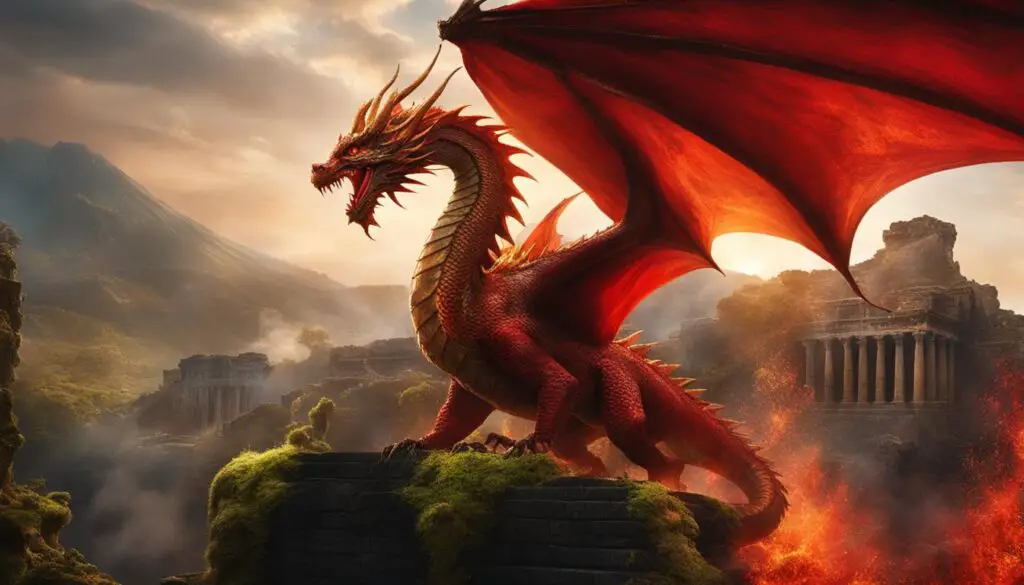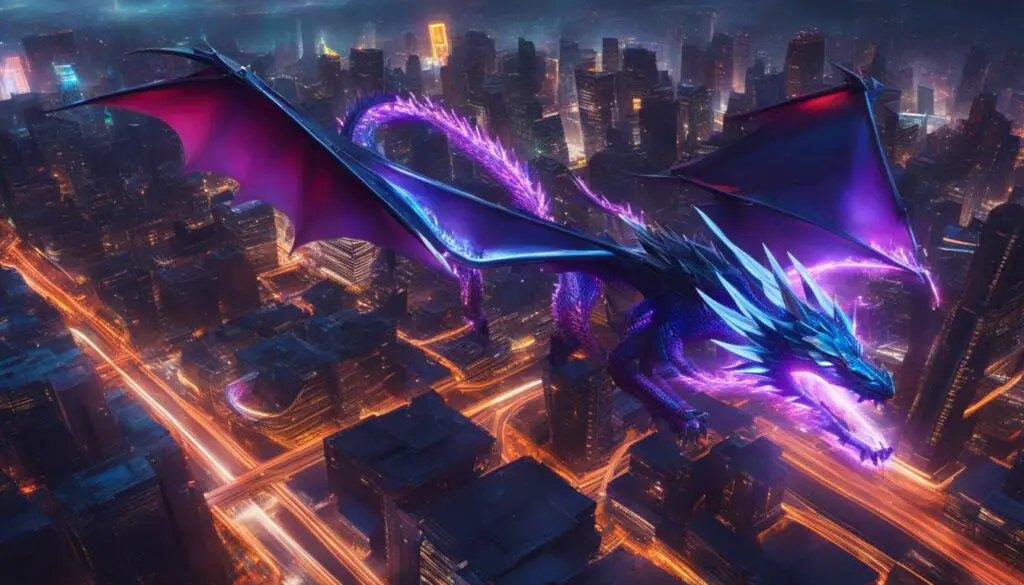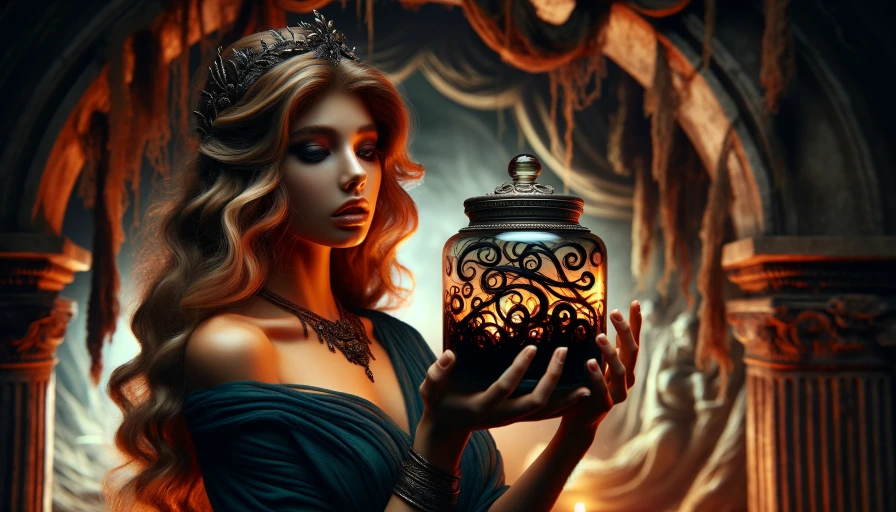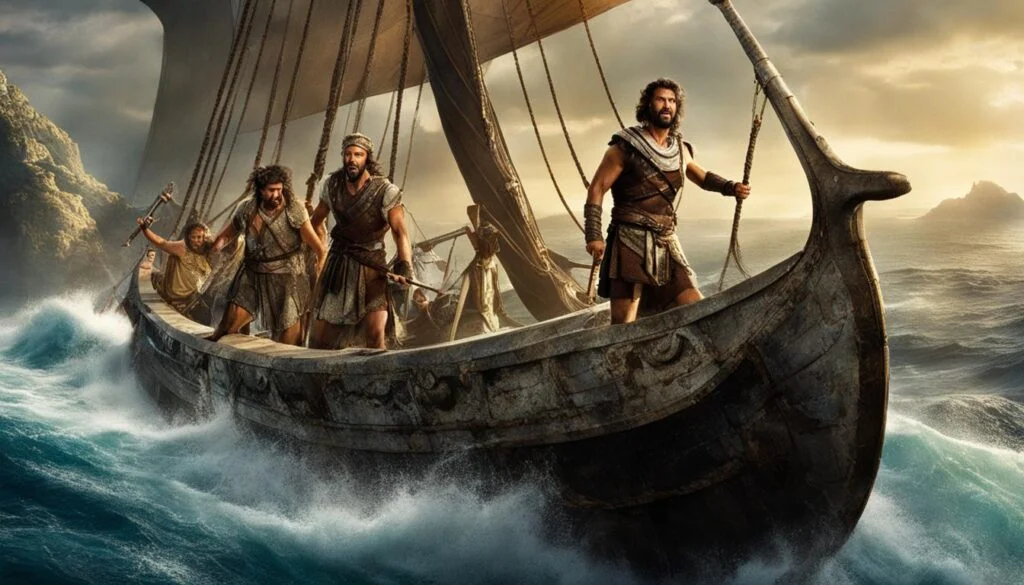Dragons are a prominent and fascinating creature found in various cultures and myths around the world. From the depictions of dragons in popular literature and movies to ancient artwork and mythology, these legendary creatures continue to capture our imagination. In this article, we will delve into the question of whether Greek mythology includes dragons, uncovering fascinating truths and dispelling age-old myths.
In Greek mythology, dragons have always been a subject of fascination. The tales of heroes battling menacing beasts have enthralled audiences for centuries. But did dragons really have a place in Greek mythology? Let’s separate fact from fiction and explore the presence of dragons in ancient Greece.
Key Takeaways:
- Dragons are legendary creatures found in various cultures worldwide.
- Greek mythology does feature dragons, although not as prominently as in some other mythologies.
- The symbolism of dragons in Greek mythology revolves around guardianship and protection.
- Dragons have captivated audiences in modern pop culture, shaping contemporary storytelling.
- The enduring fascination with dragons reflects the universal human desire to explore mythical creatures and worlds.
Dragons in Ancient Mythologies Worldwide
Dragons have long been a fascinating creature in the mythologies and folklore of various cultures around the world. From ancient Mesopotamia to Indian mythology, dragons have appeared in different forms and contexts, captivating the imaginations of people throughout history.
In Mesopotamian mythology, the Mušḫuššu, a dragon-like creature with a horned head and a serpent’s body, was believed to be a protective deity. In ancient Egypt, the dragon Apep represented chaos and was an adversary of the sun god Ra. In Indian mythology, the dragon Vritra was a fearsome serpent-like creature associated with drought and destruction.
Dragon Legends and Symbolism
The presence of dragons in various cultures reflects their symbolic significance. Dragons often symbolize power, strength, and the forces of nature. They are regarded as guardians of treasures and knowledge, as seen in the Greek myth of the dragon Ladon guarding the golden apples of the Hesperides. In Chinese culture, the dragon is a symbol of good luck, prosperity, and imperial power.
- Dragons in different mythologies: Mušḫuššu in Mesopotamia, Apep in Egypt, Vritra in India
- Symbolism of dragons: power, protection, forces of nature
- Cultural significance: guardians of treasures, symbols of good luck and prosperity
Dragons have captured the imagination of people worldwide, transcending cultural and geographical boundaries. Their presence in ancient mythologies continues to inspire awe and wonder, reminding us of our enduring fascination with these mythical creatures.
Dragons in Ancient Greek Mythology

While Greek mythology may not be as renowned for its dragons as some other mythologies, these magnificent creatures do make appearances in the ancient tales of Greece. Let’s explore the intriguing presence of dragons in Greek mythology and literature.
One of the most famous Greek dragons is the Python, a fearsome serpent-like creature that was slain by the god Apollo. In Greek literature, dragons are also mentioned, such as the blue dragon motif on King Agamemnon’s sword belt in Homer’s epic poem, The Iliad. These references, while not as prevalent as in other cultures, highlight the enduring fascination with dragons even in the ancient Greek world.
Dragons in Greek Literature
Greek literature offers various interpretations of dragons, showcasing their significance in the mythological narrative. While they may not conform to the Western representation of dragons, Greek dragons are unique and captivating in their own right. These mythical creatures often symbolize power, transformation, and the unpredictable forces of nature.
- In ancient Greek poetry, dragons are portrayed as guardians of treasures, such as the dragon Ladon who protected the golden apples of the Hesperides.
- Dragons also feature in Greek tragedy, representing the chaos and destruction that can arise from human actions. For example, the dragon spawned from the blood of the slain Sphinx in the tragedy Oedipus at Colonus.
- Furthermore, dragons appear in various Greek myths, such as the Chimera and the Hydra, each with their own unique characteristics and symbolism.
These captivating tales and literary references demonstrate the role of dragons in Greek mythology and their enduring allure.
Dragons in Greek mythology may not be as prominent as in other mythologies, but their presence adds depth and intrigue to the rich tapestry of ancient Greek culture. From the slaying of the Python to the blue dragon motif on Agamemnon’s sword belt, these mythical creatures continue to spark our imagination and fascination.
Dragon Symbolism and Interpretations in Greek Mythology
Dragons have been a part of Greek mythology, albeit not as prominently as in some other mythologies. In Greek culture, dragons are often associated with symbolism and interpretations that add depth and meaning to the stories and artworks. Let’s explore the intriguing role of dragons in Greek mythology.
Dragons as Guardians
In Greek mythology, dragons are often portrayed as fierce guardians. They are depicted as creatures entrusted with protecting treasures, such as the dragon Ladon in the Garden of the Hesperides. These dragons serve as formidable protectors, defending precious artifacts or valuable locations from intruders.
The symbolism of dragons as guardians extends beyond their physical strength. They are also imbued with a sense of authority and power, serving as a reminder of the boundaries between the mortal and divine realms. The presence of dragons in Greek mythology highlights the significance of protection and the need for vigilance in safeguarding what is valuable.
The Role of Dragons in Greek Art
Dragons have played a significant role in Greek art, where they symbolize power and protection. Their images can be found on various artifacts, such as pottery, sculptures, and architectural elements. The inclusion of dragons in art serves to evoke feelings of awe and respect, emphasizing the mythical and extraordinary nature of the depicted scenes.
These dragon motifs in Greek art often accompany scenes of heroes, gods, and mythological creatures, reinforcing the notion that dragons are intimately connected with the divine and heroic realms. The presence of dragons in Greek art not only adds visual interest but also enhances the storytelling aspect, conveying the grandeur and significance of the depicted narratives.
Overall, while dragons may not hold as central a role in Greek mythology as in some other mythologies, their symbolism and interpretations in Greek culture contribute to the richness and complexity of the ancient tales. The depiction of dragons as guardians and their significance in Greek art showcases their enduring allure and the timeless fascination they hold for both ancient and modern audiences.
Dragons in Modern Pop Culture

Dragons have captivated our imaginations for centuries, and their presence in modern pop culture continues to be as prevalent as ever. These mythical creatures have found their way into literature, movies, and TV shows, becoming iconic figures in the fantasy genre. Whether they are portrayed as majestic creatures or fearsome adversaries, dragons have left an indelible mark on our cultural storytelling.
In modern literature, dragons have become beloved characters that readers can’t get enough of. From the friendly dragon Haku in “Howl’s Moving Castle” to the wise and enigmatic Saphira in the “Eragon” series, these characters have added depth and excitement to many fantastical tales. They symbolize power, wisdom, and the fantastical worlds they inhabit, captivating readers and bringing magic into their lives.
Dragons have also found their way onto the big screen and into our living rooms through movies and TV shows. From the fire-breathing dragon Smaug in “The Hobbit” trilogy to the dragons of “Game of Thrones,” these larger-than-life creatures have brought epic battles and thrilling adventures to screens worldwide. Whether they are portrayed as allies or formidable foes, dragons have become a staple in the realm of visual storytelling, enchanting audiences with their awe-inspiring presence.
The cultural influence of dragons cannot be overstated. These mythical beings have inspired countless stories, artwork, and even video games. Their allure lies in their mystery, power, and the sense of wonder they evoke in us. As we continue to explore and create, dragons will undoubtedly remain an integral part of our cultural landscape, reminding us of the boundless possibilities of the human imagination.
Conclusion
Dragons have been captivating figures in mythologies around the world, igniting our imagination and leaving an enduring fascination. Although Greek mythology does not prominently feature dragons, they make appearances in various forms and contexts, adding a touch of intrigue to the ancient tales.
These legendary creatures hold deep significance in cultural storytelling, symbolizing chaos, power, and the forces of nature. Even in Greek mythology, dragons are associated with guardianship and protection, adding layers of meaning to the stories and artworks of the ancient Greeks.
From ancient legends to modern pop culture, dragons continue to captivate us with their timeless allure. They have become iconic characters in literature, movies, and TV shows, shaping the fantasy genre and leaving a lasting cultural influence. The significance of dragons in cultural storytelling spans across different mythologies, reflecting our innate desire to explore mythical beings and the mysterious worlds they inhabit.
Intriguing and captivating, dragons hold a special place in our collective imagination. Their presence in mythologies worldwide reminds us of the enduring allure and significance of these mythical creatures in our cultural tapestry.
FAQ
Does Greek mythology have dragons?
Yes, dragons do make appearances in Greek mythology, although they are not as prominent as in some other mythologies.
What are some examples of dragons in Greek mythology?
The Greek dragon Python, slain by Apollo, and the blue dragon motif on King Agamemnon’s sword belt in The Iliad are notable examples of dragons in Greek mythology.
What do dragons symbolize in Greek mythology?
Dragons are often associated with guardianship and protection in Greek mythology. They are depicted as creatures guarding treasures and symbolize power and protection in Greek art.
How have dragons influenced modern pop culture?
Dragons have become iconic and beloved creatures in modern literature, movies, and TV shows. From J.R.R. Tolkien’s Smaug to the dragons of Game of Thrones, they continue to captivate audiences and shape popular culture.
Why are dragons fascinating to people across different cultures?
Dragons have been a part of human mythologies for centuries, and their enduring fascination reflects the universal human desire to explore mythical creatures and worlds.




